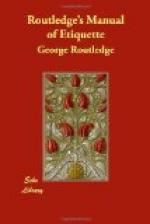* * * * *
VI.—ETIQUETTE AFTER THE WEDDING.
The dress of the bride during the honeymoon should be characterised by modesty, an attractive simplicity, and scrupulous neatness. The slightest approach to slatternliness in costume, when all should be exquisitely trim from chevelure to chaussure, would be an abomination, and assuredly beget a most unpleasant impression on the susceptible feelings of the husband. He will naturally regard any carelessness or indifference in this respect, at such a time, as a bad augury for the future.
The Wedding Cards.
The distribution of these has long been regarded as an important social duty; it devolves, as we have already said, on the bridesmaids, who meet for that purpose at the house of the bride’s father on the day after the wedding. The cards, which are always furnished by the bridegroom, are two fold—the one having upon it the gentleman’s and the other the lady’s name. They are placed in envelopes, those containing the lady’s card having her maiden name engraved or lithographed inside the fold, and have all been addressed some time before by the bridesmaids, to whom the gentleman has given a list of such of his friends as he wishes to introduce to his home.
The lady generally sends cards to all whom she has been in the habit of receiving or visiting while at her father’s house. She too has now an opportunity of dropping such acquaintances as she may not be desirous of retaining in her wedded life.
This point of sending the cards has until recently been considered as one requiring great care and circumspection, since an omission has frequently been regarded as a serious affront. To those parties whose visiting acquaintance is wished to be kept up, on the bride’s card it has been the custom until lately to add the words “At home” on such a day. But this usage is going out of vogue.
To send cards without an address is an intimation that the parties are not expected to call except in the case of friends who reside far away, or when the marriage has taken place at a distance. In fact, the address is understood to denote “At home,” by those who adhere to the custom; it is better, however, that those words should be put upon the cards.
A practice has grown up of late, more particularly where the circle of friends is extensive, to send invitations to such as are not called to the wedding feast to attend the ceremony at church, instead of issuing cards at all. When this rule is observed, it is usual in notifying the marriage in the newspapers to add the words “No Cards.”
Reception of Visitors.
On the return of the wedded pair from their honeymoon trip, about a month or six weeks after the wedding, they were, until recently, expected to be “At home;” but the formality of reception days is now generally exploded. Intimate friends, whether “At home” cards have been issued or not, will, however, be expected to pay them a visit. But if reception days have been fixed, the bride, with her husband and bridesmaids, will sit “at home” ready to receive those to whom cards have been sent, the bride wearing her wedding dress, and the company invited to partake of wedding cake and wine to drink the health of the bride.




